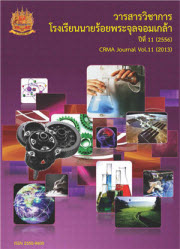การวิเคราะห์ข้อมูลเรดาร์ ESAR ในเชิงปริมาณโดยใช้ฟังก์ชันอ้างอิงแบบโพลาไรเซชัน
Main Article Content
บทคัดย่อ
ในปัจจุบันระบบเทคโนโลยีภูมิสารสนเทศได้มีการพัฒนาไปอย่างรวดเร็วและมีการนำไปใช้ประโยชน์ในด้านต่างๆ อย่างกว้างขวาง เทคโนโลยีระบบเรดาร์ Synthetic Aperture Radar (SAR) เป็นหนึ่งในเครื่องมือสำคัญที่ใช้สำหรับการสำรวจและจัดเก็บข้อมูลของพื้นผิวโลก โดยเฉพาะอย่างยิ่งในการจำแนกชนิดและประเภทของพื้นที่ต่างๆในบทความนี้จะนำเสนอแนวทางเลือกสำหรับการจำแนกชนิดและประเภทของพื้นผิวโลก โดยใช้ตัวแปรที่อาศัยพื้นฐานของการสะท้อนของคลื่นแม่เหล็กไฟฟ้าที่แตกต่างกัน ตามลักษณะของโพลาไรเซชัน โดยจะใช้เป้าหมายเฉพาะชนิดต่างๆ จำนวนสามแบบคือแผ่นเหล็กเรียบ, แผ่นเหล็กเข้ามุมสองด้าน และแผ่นเหล็กเข้ามุมสามด้านมาเป็นพื้นฐานในการหาฟังก์ชันอ้างอิง ที่ใช้ในการประมวลผลสัญญาณเรดาร์ SAR จากค่าสัมประสิทธิ์การกระเจิงของเป้าหมายโดยอาศัยหลักการทัศนศาสตร์เชิงกายภาพ แล้วจึงนำเอาข้อมูลภาพแบบโพลาไรเซชันมาทำการวิเคราะห์เชิงปริมาณด้วยตัวแปร the differential reflectivity และ the linear depolarization ratio เพื่อแสดงให้เห็นถึงประสิทธิภาพของฟังก์ชันอ้างอิงแบบโพลาไรเซชันทั้งสามแบบ
Article Details
ผลงานที่ได้รับการตีพิมพ์ ถือเป็นลิขสิทธิ์ของวารสารฯ
เอกสารอ้างอิง
Lee, J.S. and Pottier, E. (2009). Polarimetric radar imaging: from basics to applications, Taylor & Francis Group, Boca Raton.
Dybdal, R.B. (1987). Radar cross section measurements,Proceedings of the IEEE, April 1987; Vol. 75, No.4, 498-516.
Uluisik, C., Cakir, G., Cakir, M. and Sevgi, L. (2008). Radar cross section (RCS) modeling and simulation, part 1: a tutorial review of definitions, strategies, and canonical examples, IEEE Antennas and Propagation Magazine, February 2008; Vol. 50, No.1, 115 – 126.
Balanis, C.A. (1989 ). Advanced Engineering Electromagnetics, John Wiley & Sons, Inc., New Jersey.
Yanovsky, F.J., Russchenberg, H.W.J., Ligthart, L.P. and Fomichev, V.S. (2000). Microwave Doppler-polarimetric technique for study of turbulence in precipitation, Proceedings of IGARSS'00, July 2000; Vol. 5, 2296–2298.
Phruksahiran, N. and Chandra, M. (2013). Quantitative data analysis of ESAR data, URSI Germany: Advances in Radio Science,2013; Vol. 11, 291–295.
Cumming, I.G. and Wong, F.H. (2005). Digital Processing of Synthetic Aperture Radar Data: Algorithms and Implementation, MA: Artech House, Norwood.
Soumekh, M. (1999).Synthetic Aperture Radar Signal Processing with MATLAB Algo-rithms, John Wiley & Sons, Inc., New York.
Klausing, H. and Holpp, W. (2000).Radar mit Realer und Synthetischer Apertur: Konzeption und Realisierung, Oldenbourg, München.
Wu, C., Liu, K.Y., and M. Jin, M. (1982). Modeling and a correlation algorithm for space borne SAR signals, IEEE Transaction on Aerospace and Electronics Systems, September 1982; Vol.Aes. 18, No.5, 563 – 575.
Phruksahiran, N. (2013).PolarimetrischeStreuungseigenschaften und Fokussie-rungsmethoden zur quantitativen Auswer-tung der polarimetrischen SAR-Daten, PhD thesis, University of Technology Chemnitz, Germany.
Phruksahiran, N. and Chandra, M. (2013). Polarimetric radar cross section under SAR geometry,URSI Germany: Advances in Radio Science, 2013; Vol. 11, 277–282.
Curlander, J.C. and McDonough, R.N. (1991). Synthetic Aperture Radar Systems and Signal Processing, John Wiley & Sons, Inc., New York.
Skolnik, M.I. (1990).Radar Handbook, McGraw-Hill, Inc., New York.
Tomiyasu, K. (1978). Tutorial review of synthetic-aperture radar (SAR) with applications to imaging of the ocean surface, Proceedings of the IEEE, May 1978; Vol. 66, No.5, 563–583.
Elachi, C., T. Bicknell, T., Jordan, R.L. and Wu C. (1982). Spaceborne synthetic-aperture imaging radars: applications, techniques, and technology, Proceedings of the IEEE, October 1982; Vol. 70, No.10, 1174–1209.
Knott, E.F. (1985). A progression of high-frequency RCS prediction techniques, Proceedings of the IEEE, February 1985; Vol. 73, No.2, 252–264.


